|
|
Pediocactus despainii |
CACTUS ART
NURSERY
 Cultivation and Mail Sale Cultivation and Mail Sale
of Cacti and Succulents. |
|
|
|
|
|
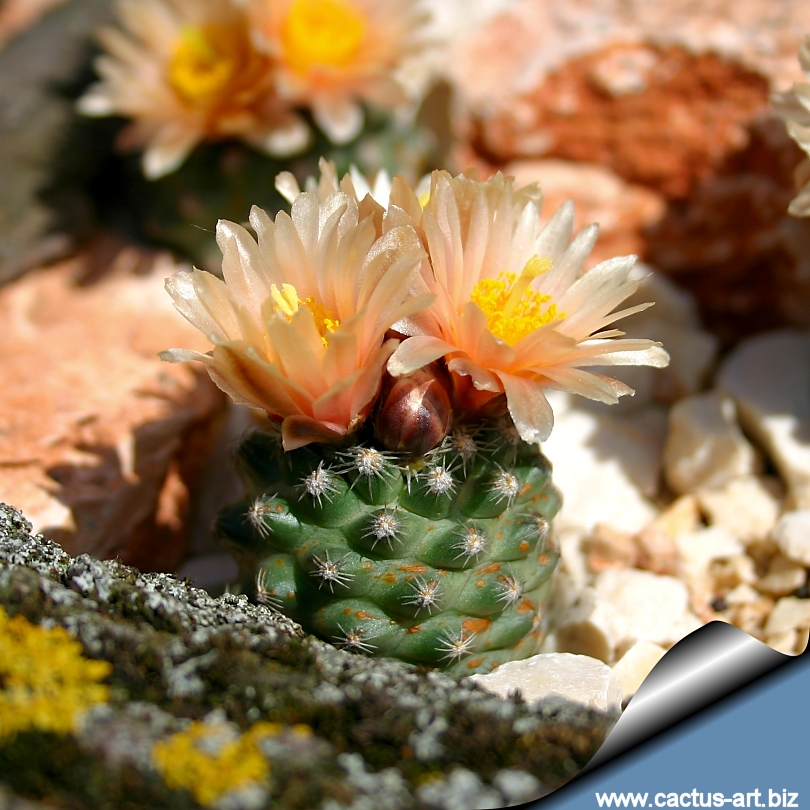
Pediocactus despainii SB1014 Near San Rafael Swell,
Emory County, Utah, USA TL
Outdoors in the rock
garden - cultivated all year round without any sheltering.
|
|
Morphology (Identifying
Characteristics): It is a small
cactus,
typically
unbranched,
but during dry or cold
weather the plants may not appear above ground at all.
(in cultivation
branching is quite common).
Stem:
Subglobose to
obovoid to
turbinate, 3.8-6 × 3-9.5 cm;
Can swell to up to
3.8-6 cm in diameter and 3-9.5 cm
in height
Roots:
Succulent and
Fasciculate.
Areoles :
Circular to oval,
villous to
glabrate.
Spines:
Smooth, relatively hard,
radial, 9-15 per areole, spreading, white, 2-6 mm. (rarely in
old plants, a small
central spine of 4-8 mm).
Flower:
Near the tip of the stem,
1.5-2.5 × 1.8-2.5 cm;
scales and outer
tepals minutely
toothed to
entire and
undulate; outer tepals yellow-bronze to peach-bronze or pink
with purple
midstripes, 4-10 × 3-6 mm; inner tepals yellow-bronze to
peach-bronze (rarely pink), 6-12 × 4-6 mm.
Blossoming time: April and
May.
Fruit:
Green, drying reddish brown,
turbinate.
Notes: This plant is a
spring ephemeral but can have - with a
good
environmental condition - a second short
growing season in
Autumn before the long
winter rest . In the
wild the species is easily overlooked except in the
spring, when they are in
bloom.
|
|
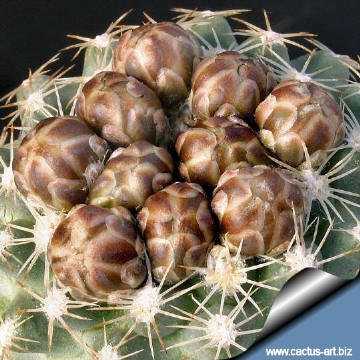
Flower buds stay
dormant on the plant
apex all the
winter |
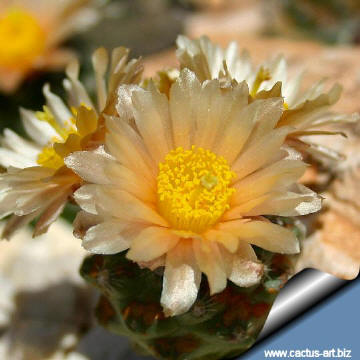
Silky shining flowers, yellow bronze to peach bronze (rarely
pink)
|
|
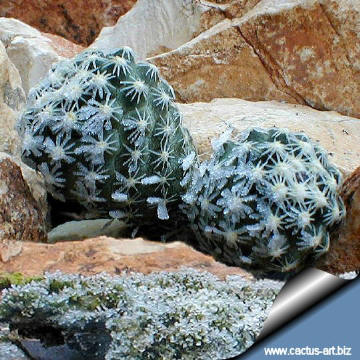
Hoar
frost |
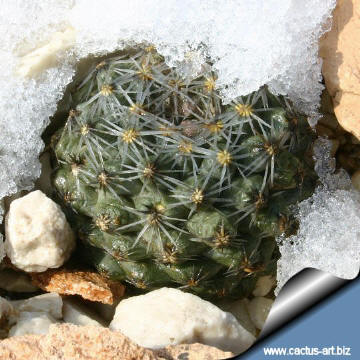
Melting snow |
|
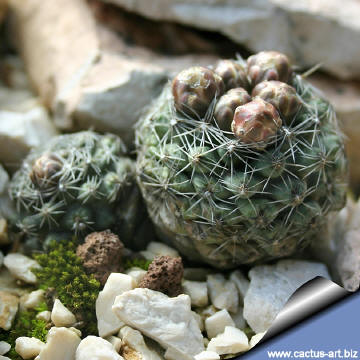
Outdoor in the garden |

Grafted on Echinopsis |
|
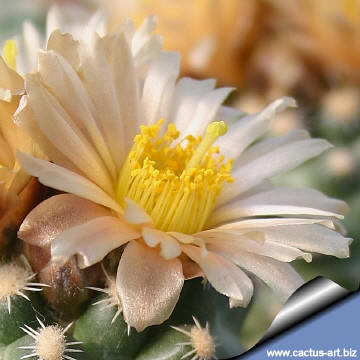 |
 |
|
. |
|
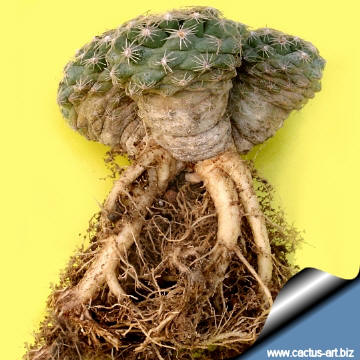
Roots |
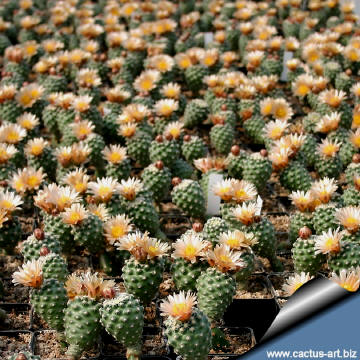
Flowering size plants Grafted on a frost hardy Opuntia compressa
stock |
|
|
|
Family:
Cactaceae
(Cactus Family)
Scientific Name:
Pediocactus
despainii
S.L.
Welsh & S. Goodrich 1980
Type:
Holotype
deposited in the
Herbarium
of the Brigham Young University,
collected
around the San Rafael Swell, Utah, on
May 5th,1978 by Despain.
Paratype
deposited in the Herbarium of the Brigham Young University, collected
around the San Rafael Swell, Utah, on the 7.5.1979 by Neese & Thorne.
Basionym:
Pediocactus despainii Welsh & Goodrich, Great Basin Naturalist,
40:83-86, 1980
Vernacular names:
-
San Rafael Cactus
-
Despain's pincushion cactus
-
Despain footcactus
Synonyms:
-
Puebloa bradyi ssp.
winkleri var. despainii
(Welsh & Goodr.) A. Doweld 1999
-
Pediocactus simpsonii var.
despainii
-
Pediocactus bradyi var. despainii
(Welsh & Goodr.) Hochst.
-
Pediocactus bradyi subsp. despainii
(Welsh & Goodr.) Hochstätter 1995
 Distribution:
This species is known in
the wild from only two
localities with a total of about 6000 individuals, it
is endemic
to Emory county in central Utah. Distribution:
This species is known in
the wild from only two
localities with a total of about 6000 individuals, it
is endemic
to Emory county in central Utah.
Habitat:
It
grows on hilltops, benches, gentle slopes and
desert pavements of cobble or pebble, in
open pinyon-juniper
woodlands
and mixed semi-arid
shrub-grassland
communities in fine textured soils rich in
calcium. At
altitudes
ranging from 1450 to 2080 meters ASL. The habitat of this species is
vulnerable.
In fact it is seriously
threatened by
over collection, surface disturbance from off-road vehicle use,
humans trampling and cattle grazing. In addition part of the
range
of this species is exposed to dangers from
exploitation of
oil, gas, gypsum and
other minerals.
Snow
usually covers the plants during the coldest
winter
month.
Conservation status:
This species was
originally listed in Appendix
II of
CITES in 1975 and uplisted to
Appendix I in 1983.
Etymology:
The
genus name
"Pediocactus"
derives from the Greek words “Pedion” meaning
“plain/level” referring to the general habitat of the plant on
the Great Plains, and the word
“cactus” ( an old genus name) The genus name implies
"Cactus of the plains"
The
species name
"despainii"
derives from the name of the discoverers: K. Despain who
discovered the plant in 1978.
|
|
|
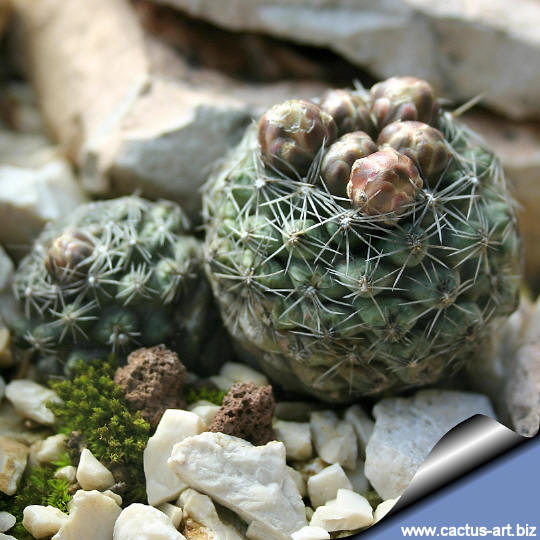
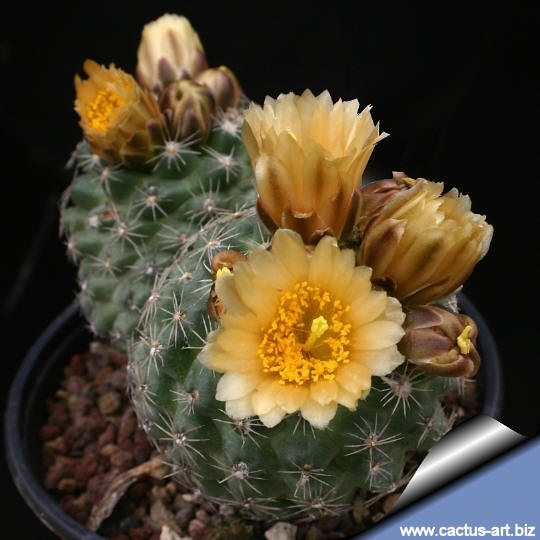
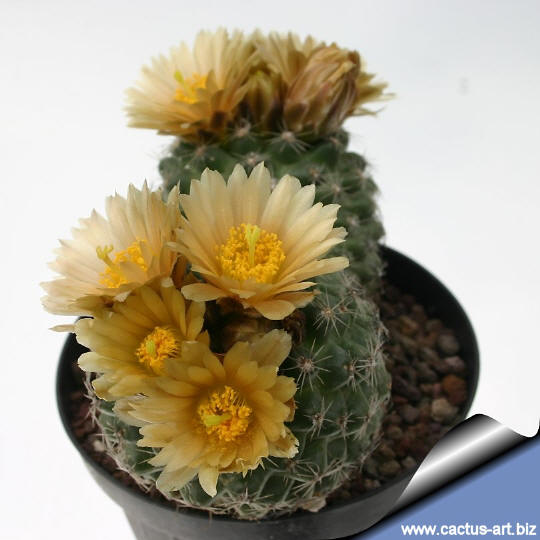
Cultivation:
Rot prone and difficult to grow on it's own roots in
cultivation
Watering Needs:
better and easier if
grafted. It needs regular water in late
winter, early spring (the short main
growing season), and also in
Autumn, when
flower buds are produced and it starts growing again. The
flowers
buds stay
dormant on the plant
apex all winter. They will then open in
spring when the temperature rises. To avoid any damage to
the buds,
don’t let grafted plants that stay in the heated greenhouse completely
dry out. Some light watering in winter is useful for keeping the flower
hydrated and
healthy.
Frost Tolerance:
Winter hardy (to
-25°)
the plants grafted on Opuntia are good for
outdoor cultivation in
raised beds, rock gardens, balconies, window sills etc..

 |
|
|
|
|